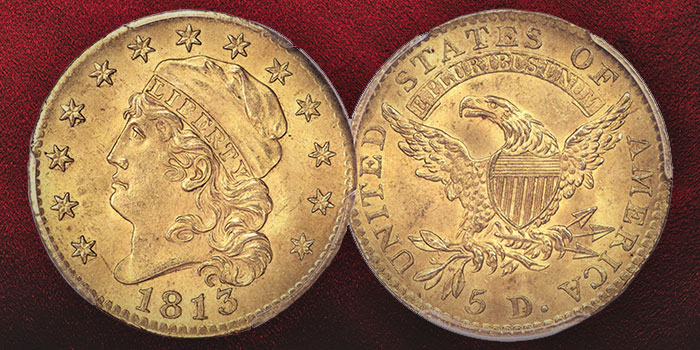
In 1813, John Reich modified his obverse design to show a more cropped portrait of Liberty than had been in use since 1807. The half eagle diameter was reduced by 1.2 mm in 1829 at the hand of William Kneass, 12 years after Reich left the Mint, but Reich’s design was not replaced until 1834. The Classic Head design introduced in 1834 signaled a weight reduction for the half eagle of 0.39 gm.
For much of the reign of Reich’s Capped Bust Left design from 1813 to 1834, the bullion weight of half eagles exceeded the coins’ face value, resulting in rampant hoarding and melting of the coins. Throughout the 1820s, half eagles were rare or nonexistent in circulation. The destruction of U.S. gold coinage during this period for profit is responsible for the rarity of most Capped Bust Left half eagles today. Thus the importance of the 1813 issue to type collectors — other dates just are not available, or they are prohibitively expensive.
The PCGS-certified Plus-graded near-Gem 1813 in our June 6-9 Long Beach Signature Auction presents an incredible opportunity to acquire a high-end example of one of the most elusive types of all early U.S. coinage. Uncirculated 1813 fives are uniquely collectible compared to other dates. The BD-1 variety is the more plentiful of two die varieties for the 1813 half eagle and a popular choice for type collectors, but there is a limit to their availability. Choice examples are typically the finest seen — and arguably the finest collectible. PCGS lists only two 1813 half eagles finer than the present coin, one of each variety. The finer BD-1 coin is the Pogue MS66 specimen. This MS64+ piece, however, stands apart on its own pedestal, carrying CAC endorsement at a slightly finer level of preservation than the typical MS64. Heritage has not previously handled an MS64 coin with a Plus grade. The most recent comparable from our archives is the MS64 PCGS CAC coin in the 2012 Philadelphia Signature Auction, which realized $47,000.
Fast forward seven years and this Plus-graded coin crosses the auction block in Long Beach. It has frosty greenish-gold luster and an even, sharp strike. Only the most insignificant luster grazes on each side prevent Gem classification. The 1813 half eagle’s popularity as a type coin will be on full display when this remarkably high-end example is offered.




